


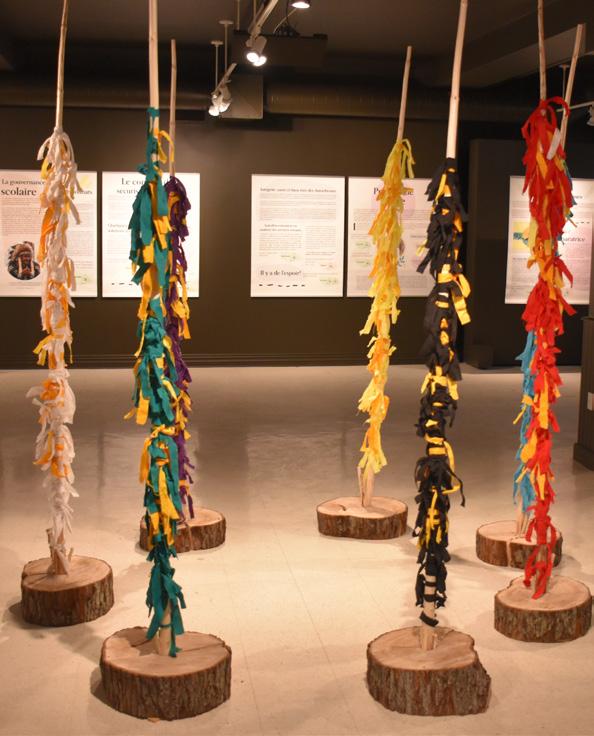
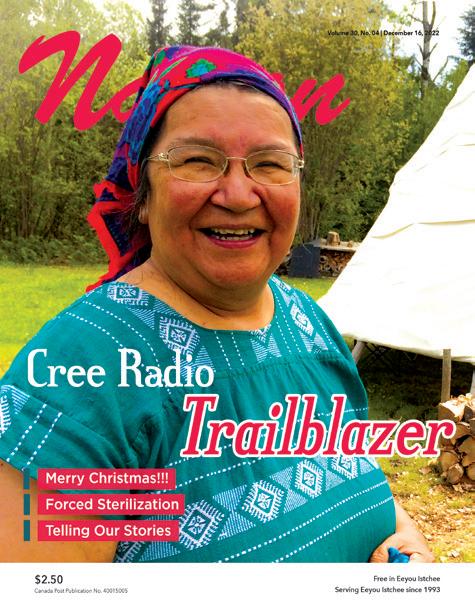









EDITORIAL T’is the season NEWS Logging on ‘The Land is Our Garden’ FEATURES Media milestones Ready for the truth Made with love Reproductive violence Maximum dignity REZ NOTES Prepping for Christmas T&B In memoriam 4 5 6 10 16 20 24 28 33 34 CONT ENTS 16 20 CBC celebrates historic milestone 10 1 800 361-2965 1 800 661-5850 ᐅᕙᓂ ᐱᒋᐊᕐᐳᖅ ᓄᓇᕕᒃ Nunavik Starts Here RESERVATIONS 1 800 361-2965 ᖃᖓᑦᑕᔫᓂᒃ ᐊᑦᑕᑐᐊᖃᕐᓂᖅ CHARTERS 1 800 661-5850 ᐅᕙᓂ ᐱᒋᐊᕐᐳᖅ ᓄᓇᕕᒃ Nunavik Starts Here Protesting Forced Sterilization Telling Our Stories Debut of Cree language programming 24 Politics
Photo of Dianne Ottereyes Reid
Puzzles will be back next issue! Special needs symposium 28
Photo by Katherine Morrow
The holidays are upon us and for most it’s a time of joy, sharing and goodwill to all. However, some people believe sharing is a one-way street leading to their own doorstep. They want to take advantage of the goodwill that these holidays taught us to believe in.
For example, I recently received a text on my phone saying, “Your TD Access Card is blocked due to unusual activities.” Rather than dealing with someone who didn’t know me, I went to my local bank to ask what the problem was. They instructed me to put my card into the reader. Then they told me that in fact I was never blocked and could they see the text on my phone.
I was lucky, they said, that I didn’t respond to the text as my phone could have been hacked – possibly leading to identity theft and access to my bank accounts. It seems that the kindergarten warning of “stranger-danger” also applies to adults, especially me.
I’m not saying that we should become paranoid, but just look at things a little more carefully. For instance, take the “Want Your Grandchild Home for Christmas?” scam. That’s where you get a call, email or text saying that one of them will be going to jail for the holidays unless a fine is paid.
As a loving grandparent you want to help. In fact, this is a common scam. Ask what police station they are talking about or where they have been imprisoned. Phone that place (not the phone number the person gave you) using Canada 411. Even better, try to contact your grandchild directly. They’ll probably ask if you’ve been sipping too much rum and eggnog



because they’re fine and in no danger of incarceration.
This is a variation of the “Emergency Scam” in which you are told that a loved one needs money right now and you are being contacted because they trust you to keep this a secret. You could tell them you want to have the loved one call you and start asking the caller questions to see if they really know the loved one. Once again, the better bet is to immediately hang up and contact the person you know. No police force in Canada would ever demand money in this fashion.
Another set-up in the holiday season is the fake toy-shop website. Prices are usually too good to be true. Some scammers in this category pose as a delivery service, saying they have a parcel ready to deliver and to click on a link. If you do, your phone is now hacked. Never click on a link sent to your phone from an unknown person.
Then there is the counterfeit merchandise scam. Dude, that Rolex is fake. You can’t buy one for a few hundred dollars. The website may have looked legitimate, but that flashy, huge discount should incite you to verify directly with the company. Better yet, block the website. If you are buying from a site like Craigslist, then arrange to meet them in person.
If you’ve been taken in, ensure your credit card is frozen as soon as possible. That way, no loans in your name can be taken out or any new accounts opened. Let the police know what has happened and follow their advice.
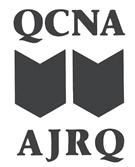
In this way we can all enjoy the holidays and hopefully force those Christmas Grinches to starve from a lack of your hard-earned money.
Happy and safe holidays from The Nation and Beesum Communications.
4 the Nation December 16, 2022 www.nationnews.ca
CONTRIBUTING WRITERS
Orr,
DESIGN
SALES
ADVERTISING
Donna Malthouse THANKS TO: Air Creebec CONTACT US: The Nation, 4529 CLARK, #403, Montreal, QC., H2T 2T3 EDITORIAL & ADS: Tel.: 514-272-3077, Fax: 514-278-9914 HEAD OFFICE: P.O. Box 151, Chisasibi, QC. J0M 1E0 www. nationnews.ca EDITORIAL: will@nationnews.ca news@nationnews.ca ADS: Danielle Valade: ads@nationnews.ca; Donna Malthouse: donna@beesum.com SUBSCRIPTIONS: $60 plus taxes, US: $90, Abroad: $110, Payable to beesum communications, all rights reserved, publication mail #40015005, issn #1206-2642 The Nation is a member of: The James Bay Cree Communications Society, Circle Of Aboriginal Controlled Publishers, Magazines Canada Quebec Community Newspaper Assn. Canadian Newspapers Assn. Les Hebdos Sélect Du Québec. Funded [in part] by the Government of Canada. | www.nationnews.ca | facebook.com/NATIONnewsmagazine | Twitter: @creenation_news CMC A AUDITED Editorial
The Nation is published every two weeks by Beesum Communications EDITORIAL BOARD L. Stewart, W. Nicholls, M. Siberok, Mr. N. Diamond, E. Webb EDITOR IN CHIEF Will Nicholls DIRECTOR OF FINANCES Linda Ludwick EDITORS Lyle Stewart, Martin Siberok PRODUCTION COORDINATOR AND MANAGING EDITOR Randy Mayer
M. Labrecque-Saganash, S.
P. Quinn, B. Powless
Ashley El Jachi, Matthew Dessner,
AND
Danielle Valade,
by Will Nicholls
T’is the season to scam you, la-la-la-la-la, la-la-la-la
I’m not saying that we should become paranoid, but just look at things a little more carefully
Logging on
Cree Lumber brings a sawmill back to Waswanipi
by Ben Powless, Local Journalism Initiative Reporter
Waswanipi previously had a sawmill that had run and shut down three times, the last time in 2006. Cree Lumber will be owned with a 51% share by the community of Waswanipi, and 49% owned by Chantiers Chibougamau.
Funding also came from Investissement Québec, Canada Economic Development for Quebec Regions, Natural Resources Canada, the Cree Nation Government and the Société de développement de la BaieJames for a total of $20 million.
“It is a great pleasure to see the next step of development for the Cree Nation of Waswanipi,” Cree Grand Chief Mandy Gull-Masty said in a statement. “The presence of partners is the key highlight to the realization of a project to enhance the rightful place of Indigenous peoples in one of the key industries of our region.”
The mill comes along at a time when lumber is desperately needed across Cree communities, after global shortages during the pandemic. Cree communities have identified 5,250 single-family dwellings that are needed in the next 15 years to meet housing needs.
Waswanipi holds a wood allocation and a historical mill permit to harvest timber through its forestry company, Mishtuk Corporation. Former chief of Waswanipi Paul Gull takes over as the company’s CEO and board chair.
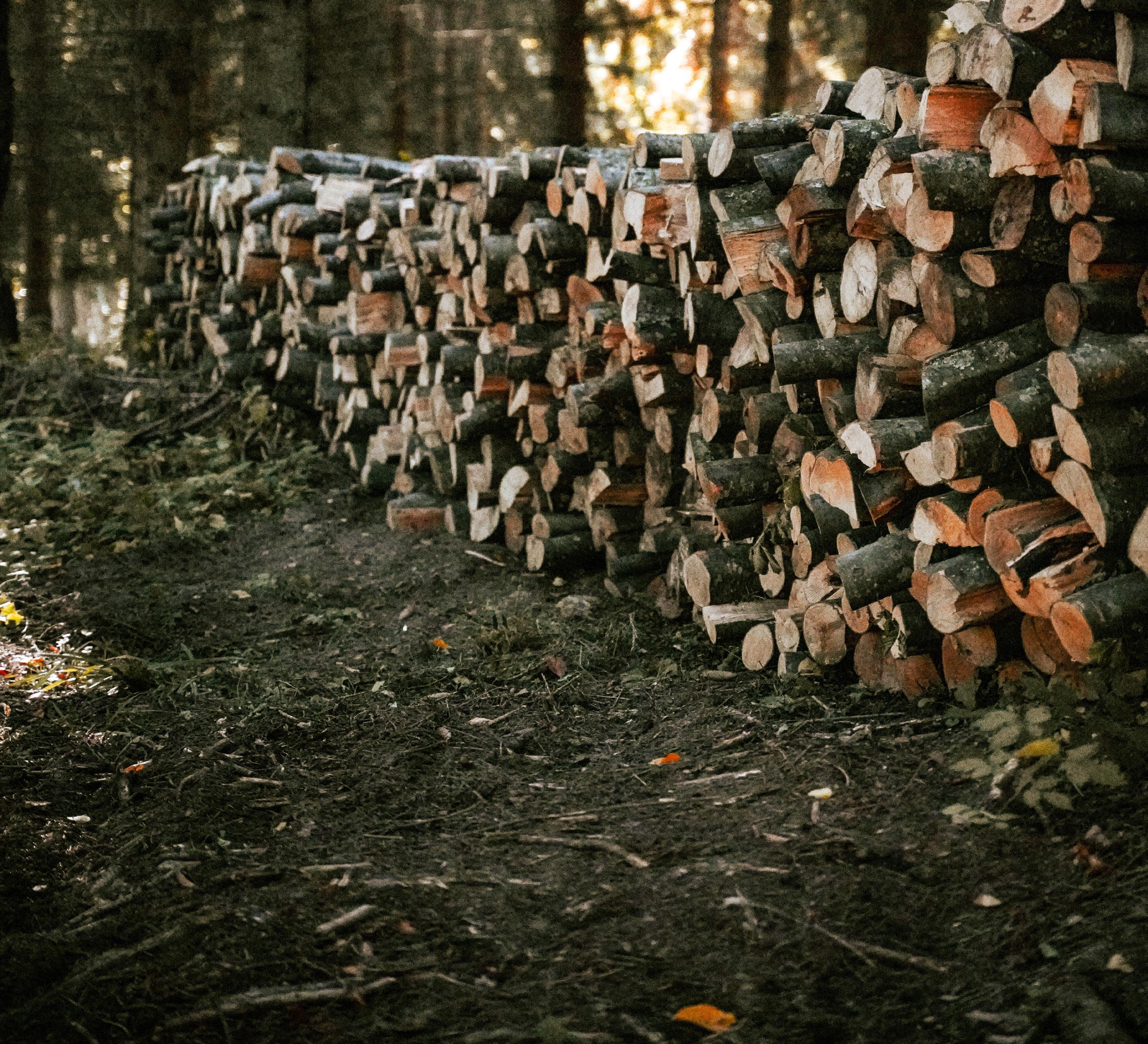
“It’s all about sustainability: we take only what we need to sustain ourselves,” Waswanipi Chief Irene Neeposh said
in a statement. “Having the mill reopen allows people to be part of the solution in addressing the housing crisis and encourage them to build their own home so we’re not so heavily dependent on social housing.”
Gull said the announcement was the culmination of 30 years of work, when the late Peter Gull began pushing for the community to run its own sawmill. However, the sawmill at the time had issues with past partners and was not able to compete in the market, forcing it to shut down at different times and lay off workers.
This announcement comes a year after Waswanipi and Mistissini signed a memorandum of understanding covering 350,000 cubic metres of wood allocated to the communities under the Paix des Braves agreement. That agreement designated 225,000 cubic metres to Waswanipi, of which 75,000 was designated to the mill and 155,000 was designated to Mishtuk.
This new mill would allow the community and the company to enter into other joint ventures, Gull said. Right now, the company’s plan is to be able to sell 20% of the lumber directly to Cree communities to be used for housing, with the rest going to lumber markets.
Eventually, the company hopes to create value-added products, including trusses, windows and doors. In the long term, Gull foresees selling biomass, for example, to heat greenhouses.
The mill is not yet open, as the company is still hiring, but Gull said he expects it to be running in the new year. It could create up to 60 jobs, he said, working two shifts. If the company can secure enough lumber, they could eventually move to 90 jobs in a 24-hour operation.
While mill work was traditionally seen as hard physical labour, Gull said that much of the process was now automated and computerized, meaning that people of all ages and genders could apply. He noted that Chantiers Chibougamau had a 30% female workforce. He added that he expects other jobs to be created as a result, including in transportation.
One of the challenges for the company will be securing high-quality timber. Gull said that the government had auctioned off wood that was five kilometres away from the community, which was “totally unacceptable to us.”
“We’ve confronted the government on that issue. They are trying to find a way to resolve that situation, but in reality they’re taking our best wood within a 60-kilometre radius of our mill,” he added. This wood is among the best in the world, and Gull said he’d like to get the 50 or 60 kilometres around the mill protected.
Gull added that he wanted to thank all the employees who have hung around since the beginning for continuing their support for the mill. “Thank you very much, have a Merry Christmas and a Happy New Year!”
www.nationnews.ca December 16, 2022 the Nation 5 Editorial News
James Bay lithium mine project raises community concerns
by Patrick Quinn, Local Journalism Initiative Reporter
Photo by Paul Dixon
Final community consultations in Eastmain, Waskaganish and Waswanipi raised passionate concerns about the potential impacts of the proposed James Bay Lithium Mine, which would be located approximately 130 km east of Eastmain, 10 km north of the km 381 truck stop along the Billy Diamond Highway.
Galaxy Lithium intends to begin operations in 2024 for 18.5 years, extracting about 173 million tonnes of ore through drilling and blasting. Following the public comment period that ended November 11, the Impact Assessment Agency of Canada (IAAC) has been preparing its final report.
“We’ve heard concerns from the communities about water quality, fish habitat, species at risk and the impact of increased road traffic on Billy Diamond Highway,” said the IAAC’s Véronique Lalande. “To create the mines, the proponent will have to create a pit dewatered to extract the ore, which will cause the gradual drying up of Lake Kapisikama as of the fourth year of operation.”
Although the company suggested the lake doesn’t offer optimal conditions for its yellow perch and other fish because the individuals captured were small, it proposed addressing concerns by relocating these fish to a “favourable habitat”. A compensation plan for the loss of water bodies will be developed, with monitoring of groundwater and surface water quality and quantity.
For the project’s infrastructure, including three stockpiles, a concentrator facility and a workers’ camp, 304.71 hectares of wetlands would be lost, which is more than the Whabouchi, Rose and Eleonore mines combined. Treated water would be discharged into stream CE2, navigation of stream CE4 would be affected, and dust deposits would impact local air and water quality.
Galaxy Lithium said these effects would be mitigated through water monitoring at the truck stop, regular spraying of the roads and work areas with water and monitoring of animal tissues typically consumed as traditional food. While 12 trucks would transport product to Matagami daily, this number would be reduced to 10 during hunting seasons.
“The major impact for our Waswanipi traplines would be noise and road traffic,” said Waswanipi’s mining coordinator Joshua Blacksmith. “We have land users who live on the land year-round. They are concerned there’s going to be big trucks hauling the ore – the wildlife will move.”
Blacksmith’s department was established six years ago to address the lack of communication between land users and mining exploration companies, which currently only inform the community about early exploration with no consultation whatsoever. While the Paix des Braves spec-

6 the Nation December 16, 2022 www.nationnews.ca
Land is Our Garden
ifies site restrictions for forestry, mining companies have been found throughout the territory.
“Work sites are moving north, which causes us to adapt a different hunting style,” Blacksmith told The Nation. “One of the main concerns was our waterways, protecting the traditional water routes that were used by our ancestors. If there’s any sort of spill, we need to have an emergency plan to protect our rivers, streams, lakes and, of course, fish.”
Waswanipi developed a Mineral Exploration Agreement to set guidelines for mining exploration and ensure that companies restore abandoned sites under the supervision of tallymen and land users. Over 100 orphaned sites in its territory still require restoration.
After first being contacted by the company two years ago, Blacksmith has remained in regular contact, most recently following its community consultation November 8. Led by the Joint Assessment Committee, composed of representatives from the IAAC and the Cree Nation Government and co-chaired by John Paul Murdoch, it drew nearly 60 attendees, about double the turnout in Waskaganish a few days earlier.
Councillor Don Saganash asked why the company’s representatives were absent from the presentation, leaving the pressure on local administrators. Tallymen highlighted that river studies are too limited because the waterways are interrelated and suggested that companies visit their traplines to witness these negative impacts.
“There’s a reaction on beaver fur even outside their jurisdiction,” said Freddie Dixon, who works with the local Cree Language Commission. “I went to trap and hunt with Michael Neeposh, who caught that beaver that had a weird taste. Even though the Bachelor mine near Waswanipi closed, we’re still impacted today. How much more do we need to damage?”
Residents remember that Waswanipi River was contaminated by a long-abandoned mine site in Chapais, requiring an extensive cleanup process. Many believe that toxic reservoirs remain from the dozens of mines once active in the Chibougamau area, potentially seeping into the food chain and causing acid rain.
“They’re not thinking about these mines being around forever,” noted tallyman Paul Dixon. “Chibougamau mines are gone, and we’re stuck with the mess. I don’t think the white man understands the impact of development – how can they guarantee our waters won’t be affected?”
Dixon believes these consultations are biased towards unchecked development, leading to further deforestation, noisy roads and wildlife depletion. Others voiced similar concerns at the consultation – Charlie Ottereyes “FM” declared “enough mining – you’re making the Elders tired destroying the land.”
While lithium is essential for the batteries powering electric cars, some experts question how green this energy really is. The Montreal-based water protection organization Eau Secours is concerned that Galaxy Lithium has no
identifiable measures to manage arsenic contamination from the uncovered rock, instead assuming the pit will naturally flood following its useful life.
“These levels of arsenic would not only violate federal regulations but also contribute to significant degradation of the surrounding ecosystems for decades, if not centuries,” mining analyst Émile Cloutier-Brassard wrote to the IAAC. “The arsenic-laden water would eventually flow into stream CE3, which flows into Asiyan Akwakwatipusich Lake a few hundred metres downstream.”
Cloutier-Brassard told The Nation the company has still not specifically addressed long-term mitigation measures for contamination or wetland destruction besides vague assurances to propose additional models during the project’s first years.

Reading through the “brutally honest” feedback posted at the consultation, it was clear to Freddie Dixon that people want real accountability from companies on their territory, responding to all concerns until gaining the community’s approval. Instead of debating the consequences of mining, he would like to see more focus on healthier initiatives like greenhouses.
“There’s traditional healing medicine in the same black rock under the soil sometimes used in lithium that we should try to preserve,” he said. “The land is our local garden and pharmacy. With the pandemic, cedar tea was the best medicine ever. Is this the way we’re going to treat the medicine we survived from?”
www.nationnews.ca December 16, 2022 the Nation 7
‘The
’





ouwahstore@gmail.com www.ouwahstore.com (514) 588-3162 18 Fort-George Road importance of life insurance,



HAPPY HOLIDAYS AND A HAPPY NEW YEAR ᒑ ᒥᔻᔨᐦᑎᒫᒄ ᒑ ᐄᐙᔒᐅᒌᔑᑳᒡ ᑭᔮᐦ ᒑ ᒥᔻᔨᐦᑎᒫᒄ ᒑ ᐅᔅᒋᐱᐳᐦᒡ HAPPY HOLIDAYS AND A HAPPY NEW YEAR ᒥᔻᔨᐦᑎᒫᒄ ᒑ ᐄᐙᔒᐅᒌᔑᑳᒡ ᑭᔮᐦ ᒑ ᒥᔻᔨᐦᑎᒫᒄ ᒑ ᐅᔅᒋᐱᐳᐦᒡ HAPPY HOLIDAYS AND A HAPPY NEW YEAR ᒑ ᒥᔻᔨᐦᑎᒫᒄ ᒑ ᐄᐙᔒᐅᒌᔑᑳᒡ ᑭᔮᐦ ᒑ ᒥᔻᔨᐦᑎᒫᒄ ᒑ ᐅᔅᒋᐱᐳᐦᒡ
Media Milestones
Broadcast pioneers recall debut of Cree-language programming

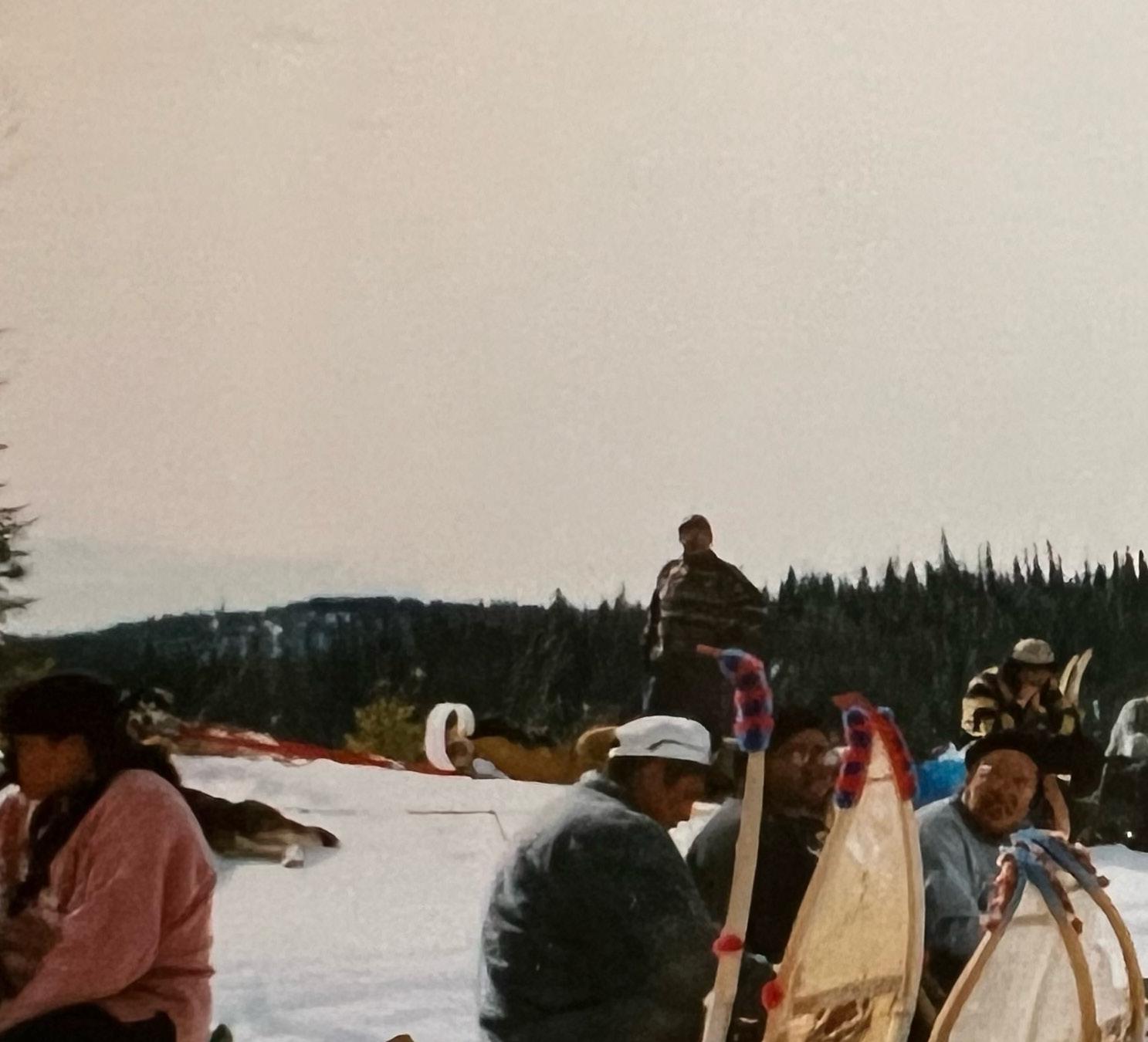 by Ben Powless, Local Journalism Initiative Reporter
by Ben Powless, Local Journalism Initiative Reporter
Features
Dianne Ottereyes Reid had a powerful reason to join a fledgling CBC unit created to broadcast in Indigenous languages across Quebec a half century ago.
“For me, the foremost reason why I jumped on the bandwagon was the fact that I went to residential school,” Reid said. “Having experienced being suppressed for speaking my language, when I left, I swore I wouldn’t let anyone stop me from speaking my language again.”
The CBC Cree radio and television branches celebrated their 50th and 40th anniversaries this November, with the CBC North Cree unit beginning radio broadcasting in 1972 and the first Cree
television show, Maamuitaau, being launched in 1982.
CBC held an event at their new Maison de Radio-Canada in Montreal to mark the milestones November 24, when they recorded a special radio broadcast featuring some of the first members of the Cree unit.
The Cree-language programming was introduced with short segments aired during Inuktitut programming. Inuk broadcaster Elijah Menarik was the first to speak Cree as part of the radio programming. Menarik had learned Cree after running away from residential school and living with a Cree family for two years.
In 1975, the hour-long show Najawew Dipajimoon began (later renamed Eyou Dipajimoon). In 1980, a Cree morning show was added, called Winschgaoug. The Cree programming came at a crucial time for the Cree nation, as the James Bay and Northern Quebec Agreement was just signed in 1975.
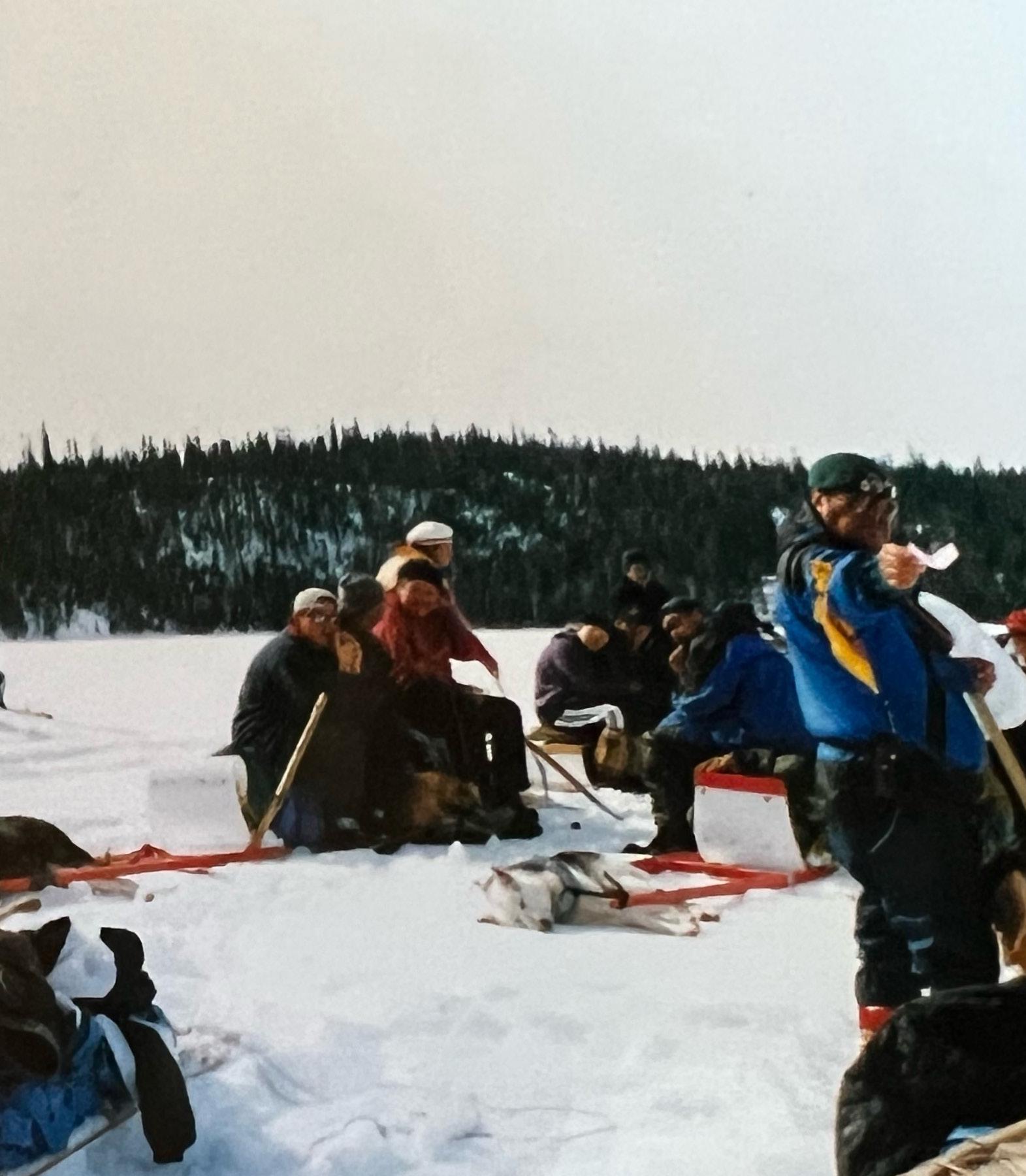

Emma Saganash and Reid were two of the earliest employees, joining in 1977 and 1975 respectively. Reid told The Nation that she originally was studying linguistics in the mid-1970s when a friend who was a journalist at Radio-Canada approached her about a new opportunity.
“She said there’s something exciting coming up; the federal government
has announced a national program for Indigenous broadcasting. It’s going to be a whole new field,” Reid recalled.
Reid ending up going to Radio-Canada and joined a committee to help set up community radio in Quebec for First Nations communities, doing community radio training with First Nations from all different nations across the province. Reid stayed at CBC until 1986.
Her passion to keep the language alive was what initially drew her to linguistics and kept her working in radio and television.
“I understood that mass media is a powerful medium of influence, to communicate with one another,” Reid explained. “If we have regional radio stations, we can bring news in the Cree language to the Cree people so they can know what’s
going on in the world. And bush people can hear it on short wave.”
She credits the introduction of Cree radio and television with strengthening the sense of nationhood and self-determination as Crees everywhere could learn about what their leaders were doing to advocate for their rights.

Some of her best memories of that era come from visiting Elders in the bush who had heard her programming. “They’d say, ‘Oh, I always listen to you every day! I finally get to meet Dianne Reid!’” she added with a laugh.
Now, she’s happy to see how far the Cree unit has come. Once relegated to
12 the Nation December 16, 2022 www.nationnews.ca
“There’s something exciting coming up; the federal government has announced a national program for Indigenous broadcasting. It’s going to be a whole new field”
- Dianne Ottereyes Reid
what she called a basement storage unit, she was overjoyed to see that the unit is prominently featured at the entrance of the new Radio-Canada building.
“I said, my goodness, after 50 years we’ve come a long way, we’re in the lobby at the front door!” she shared with a smile. “We’re not in the dungeon anymore!”
Saganash recalled that CBC Radio began hiring Cree students studying in Montreal in the 1970s to do five-minute newscasts during the week. One day she got a phone call asking if she wanted to try radio.
“I thought that was very interesting. The person said, ‘Why don’t you come out and try it? We’re going to do some training.’ I tried it out, and loved the idea of radio,” she said.
After going on maternity leave in 1981, Saganash worked at the local Friendship Centre for a few years before returning to CBC in 1985 and staying another three years. She returned in 1998, going on to host Maamuitaau for 10 years, retiring in 2018 after having moved into management.
“I believe that our programs meant a lot to the Cree people up North,” she shared. People were amazed when they first heard Menarik speak Cree, which helped to spur the development of Cree programming.
The programming back then focused not just on news and weather, but also the status of patients who had gone south for treatment, as well as covering Cree legends, myths and stories. Saganash heard
that people would record them and listen to them before bed.
Stories that stood out for her included covering a 1,300 kilometre walk across the Cree nation to raise money for dialysis machines for patients in the North, because of how many people were involved. Another trip took her to Moose Factory, where her siblings were sent for residential school, including a brother who never returned home.
“I finally found where he was laid to rest, in an unmarked grave. I taped the finding, and I showed it to my mom. For her it was closure. She cried so much that day,” Saganash shared. She found the grave on December 6, 1994, 40 years to the day after he passed away in 1954.

www.nationnews.ca December 16, 2022 the Nation 13



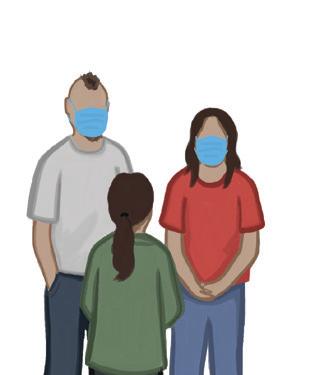
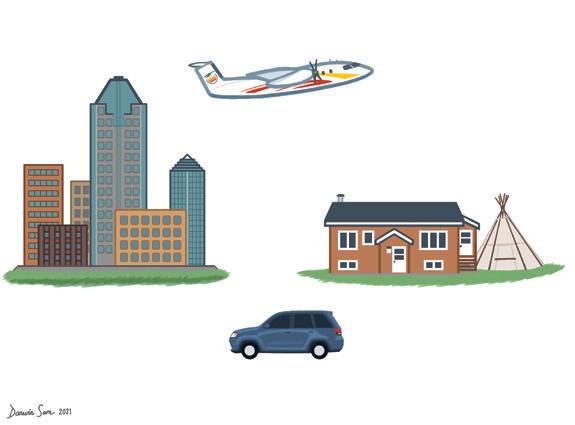

Keep the circle of protection strong ᐁᐅᒄ ᐆ ᒨᔥ ᒉᐧᐄ ᐃᐦᑎᔨᓐ Make it a habit ᐁᐅᒄ ᐆ ᓇᑲᔮ ᒉᐧᐄ ᐃᐦᑎᔨᓐ For more information: creehealth.org/covid KEEP THE CIRCLE OF PROTECTION STRONG THIS WINTER GET TESTED if you travel, gather, have symptoms, or before medical appointments STAY HOME if you’re sick or test positive, and follow isolation recommendations WEAR A MASK when recommended, especially around people with vulnerable health Keep your VACCINATION UP TO DATE Keep the CIRCLE OF PROTECTION STRONG COVID_MakeItAHabit_NationAdHorizHalfPage_20221125_v1_print.pdf 1 2022-12-02 2:47 PM











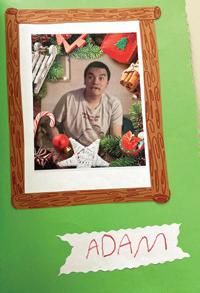




Chisasibi 1.888.825.3458 Whapmagoostui 1.888.863.5942 ᒑ ᒥᔪ ᐊᔨᐧᐋᔑᔮᒄᐦ/ᒋᐧᐋᒋᔮᒥᑎᓈᓐ ᐆ ᒑ ᒧᒋᒑᔨᐦᑖᑯᐦᒡ Happy Holidays Branch Holiday Hours Monday, December 26th (in lieu of Christmas Day) Closed Tuesday, December 27th (in lieu of Boxing Day) Closed Wednesday, December 28th Regular Hours Thursday, December 29th Regular Hours Friday, December 30th Regular Hours Monday, January 2nd (in lieu of New Year’s Day) Closed Tuesday, January 3rd (Bank Holiday) Closed Wednesday, January 4th Regular Hours In this holiday season, our best wishes for peace, love, and prosperity. En cette période des Fêtes, meilleurs vœux de paix, d’amour et de prospérité. ᒋᔮᒫᔨᐦᑎᒧᐎᓐ, ᓵᒋᐦᐄᑐᐎᓐ, ᒥᔪᐱᒫᑎᓰᐎᓐ ᑭᔮ ᐱᑳᔅᒋᐦᐅᐎᓐ ᐆ ᒑ ᐅᔅᒋᐱᐳᐦᒡ Wishing you a joy-filled holidays season and a wonderful year to come. Nous vous souhaitons des fêtes de fin d'année remplies de joie et une merveilleuse année à venir. ᒉ ᐧᐄᐦ ᒥᔪᐱᔨᔨᓐ ᐆ ᒉ ᐲᐦᒉᒪᑲᐦᒡ ᑲᔦᐦ ᐆ ᒉ ᐅᔅᒋᐱᐳᐦᒡ! Happy Holidays! ᒥᔪᐲᐦᒉᒪᑲᓂᐦᑖᐦ! Joyeuses fêtes ! In honour of the year of Special Needs, here are the artwork submissions for the CSB Christmas Card Contest.
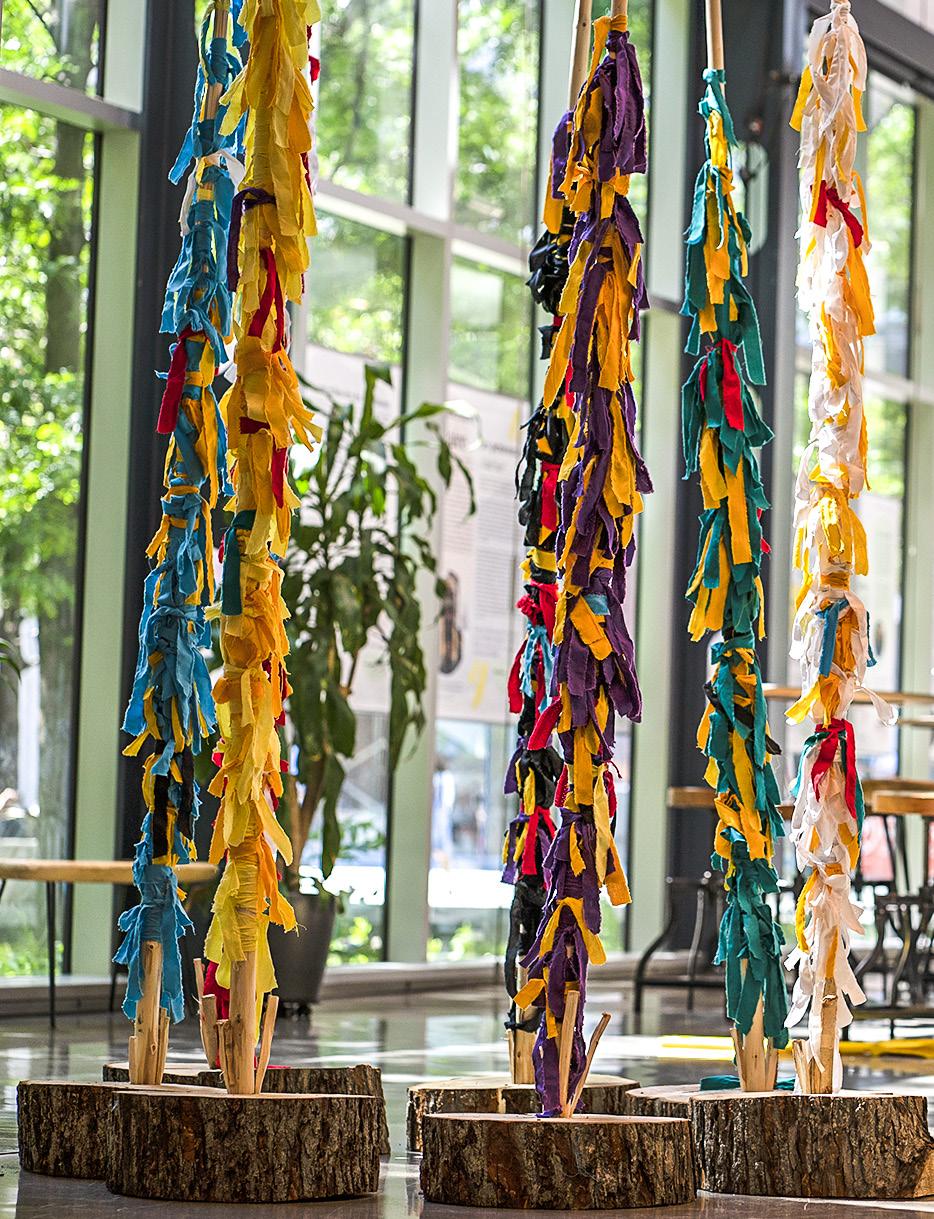
READY TRUTH FOR THE
Laissez-nous raconter sheds light on Indigenous realities
 by Patrick Quinn, Local Journalism Initiative Reporter Photo by Maude Debois
by Patrick Quinn, Local Journalism Initiative Reporter Photo by Maude Debois
Exciting new initiatives are providing platforms for Indigenous peoples to share their realities. A new four-part Radio-Canada/CBC documentary series Laissez-nous raconter (Telling Our Story) is one ambitious project developed over the past four years.
Having travelled 26,000 km over 75 days of filming, Abenaki director Kim O’Bomsawin said the series gives the talking stick to 100 protagonists from 30 First Nations and Inuit communities across Quebec. The script is based on extensive interviews and field research gathered by a team from each of the province’s 11 First Peoples.
“It was very important for me that the content reflected what was important to the people,” O’Bomsawin told The Nation “Researchers went inside their own communities looking for the best knowledge keepers or those who had the legitimacy to speak on behalf of their people. That’s
what makes the documentary so authentic.”
Notable voices such as Innu surgeon Stanley Vollant, former Cree Grand Chief Matthew Mukash and Wendake actor Brad Gros-Louis discuss their respective culture’s history and worldviews with warmth and humour while sharing ancestral knowledge.
Although it addresses painful subjects, O’Bomsawin was adamant in saying that the series isn’t victimizing. Instead, it’s an opportunity to dissolve prejudices and demonstrate the richness of Indigenous values and wisdom through intimate storytelling.
“My main purpose was to celebrate our cultures, show people our strength and to tell the world that we’re not only here surviving but regaining our power,” explained O’Bomsawin. “I’ve been doing this almost 15 years and still every day
of shooting I learned something new – it was a real privilege.”
With stunning images and engaging editing, the series weaves segments around themes such as identity and spirituality that illustrate similarities and differences between cultures. For instance, viewers learn Inuit techniques for building a perfect igloo followed by Abenaki secrets of basket-making.
The first episode analyzes the profound connection that Indigenous peoples have with the land, from traditional harvesting methods to the impacts of dams in Eeyou Istchee. Quentin Condo, aka Mi’kmaq rapper Q052, shared his techniques for clam digging in Gesgapegiag and composed the climactic slam poem that is recited by youth at the summit of Mount Royal.
“It gave me a sense of hope seeing youth from each Nation addressing all of these issues for us as a unit,” said Condo.
17 The Nation December 2, 2022 www.nationnews.ca

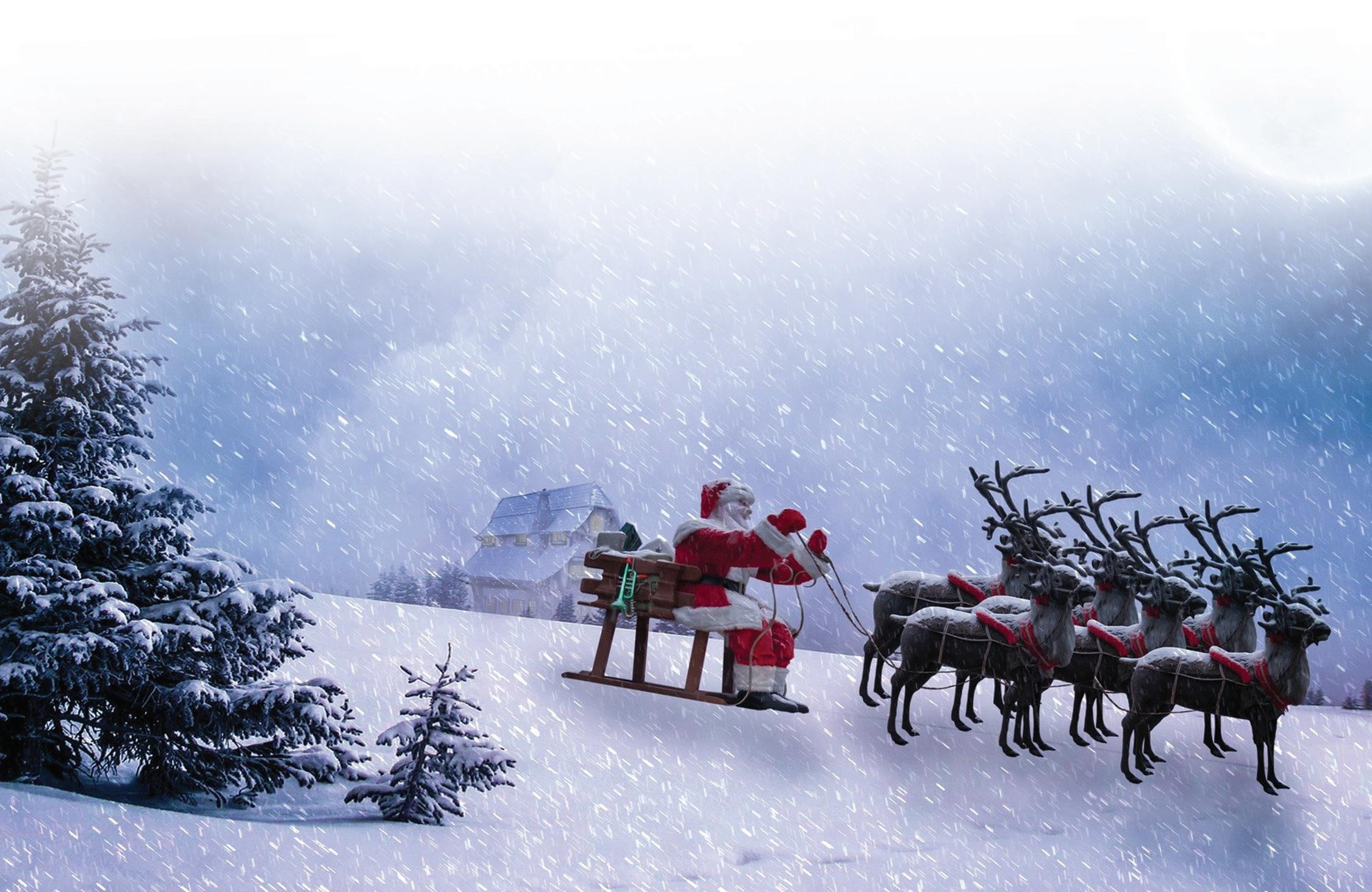
Merry Christmas and Happy New Year to all. ᒥᓯᐙ ᒑ ᒥᔻᔨᐦᑎᒫᒄ ᒑ ᒥᑯᔖᒌᔑᑳᒡ ᑭᔮ ᒑ ᐅᔅᒋᐱᐳᐦᒡ᙮ the Nation team May the Peace and Joy of the holiday season be with you throughout the coming year. Merry Christmas from all of us at CSB Post Secondary Student Services. ᑭᒫ ᒋᔮᒫᐅᐙᔨᐦᑎᒫᒄ ᑭᔮ ᒥᔻᔨᐦᑎᒫᒄ ᐆ ᒑ ᒥᑯᔖᒌᔑᑳᒡ ᑭᔮ ᐆ ᒑ ᐅᔅᒋᐱᐳᐦᒡ᙮ ᒑ ᒥᔪᒥᑯᔖᒌᔑᑭᓂᐦᑖᔮᒄ ᐅᐦᒋ ᐅᑖ ᓂᔮᓐ CSB Post Secondary Student Services. 1440 Ste-Catherine St, West Suite 400, Montreal Qc, H3G 1R8 Tel: 514-846-1155 | Fax: 514-846-1266 | Toll Free: 1 800-463-740
“I worked with the kids to deliver the slam and get the angles I wanted – my son did the Mi’kmaq part. Being at the historic point of the Great Peace signing in 1701 and having all The Nations there was powerful.”
In the second episode, Condo demonstrates a traditional Mi’kmaq cooking technique with a hollowed-out log that he had heard about from Elders’ stories but had never witnessed it because the cultural practice had long been suppressed. Now he tries to pass it on to others as an act of reclamation.
“It was completely lost in our community for very many years,” explained Condo. “Even my grandparents didn’t remember how to do it. I believe it’s our responsibility when it comes to the perpetuation of the culture.”
In the same vein, members of diverse communities shared their favourite words and expressions in their mother tongue. After discussing the healing power of preserving his endangered Wolastoqiyik language, Jeremy Dutcher delivers a memorable performance in a forest accompanied only by piano and archival recordings from a century ago.
“When we have our young people rooted in our way, they can take on any challenge because they know who they are,” Dutcher states on-screen. “I was given a gift from my knowledge keepers. You damn well better know your language, your songs, because they’re going
to protect and connect you, to the ancestors, the land, all of it.”
Laissez-nous raconter ends on a hopeful note, exploring how Indigenous knowledge can illuminate solutions for issues like the climate crisis. The series showcases the spirit of sharing inherent to Indigenous cultures with a willingness to nurture understanding.
“We strongly believe we have those answers within us,” asserted
O’Bomsawin previously worked together on the award-winning podcast series Telling Our Twisted Histories.
Likewise, the travelling exhibition Voies Parallèles, which was presented at Montreal’s First Peoples Festival last August and recently opened in Repentigny, is similarly solution-focused and rooted in a successful podcast series. The artistic installation aims for inclusivity in sharing traditions and culture of the Atikamekw Nation.

“Voies Parallèles was a podcast that was born a few days after Joyce Echaquan’s death,” explained project leader Laurence Depelteau-McEvoy. “That was very shocking for everybody and mind opening for others. We collaborated with several Indigenous people from different generations and communities to share their unique realities.”
O’Bomsawin. “More than this, there’s a curiosity among the young generations of non-Indigenous people. The timing is perfect for a documentary that isn’t there to accuse but just show what we’ve been through, what we are and what we will continue to be.”
Produced by Francine Allaire for Terre Innue based on a concept from the late Réginald Vollant and Ian Boyd, the series benefits from an extraordinary team of primarily Indigenous talent, including Innu poet Marie-Andrée Gill and Atikamekw artist Eruoma Awashish. Allaire and
Depelteau-McEvoy said that the exhibition’s visitors have been profoundly touched by the testimonies and believes there’s a growing urgency to elevate traditional values. Along with the exhibition, Repentigny’s Centre d’art Diane-Dufresne is planning a series of meetings with Indigenous leaders and various cultural mediation activities.
“Our people are ready to be heard and they feel people are ready to hear the truth,” said O’Bomsawin. “There’s also going to be an international version so my biggest hope is that other First People, in Canada or Africa or wherever, will see we can tell our own stories.”
www.nationnews.ca December 16, 2022 the Nation 19
The series weaves segments around themes such as identity and spirituality that illustrate similarities and differences between cultures
Photo by Beniot Chapmange
Made with love
Emerging opportunities for Cree artisans
by Patrick Quinn, Local Journalism Initiative Reporter
With a resurgence in traditional arts and craftwork, Cree artisans are finding exciting new avenues to showcase their talents. The Cree Native Arts and Crafts Association (CNACA) is expanding its inventory as it prepares to open new stores both online and in Montreal in 2023.
In September, CNACA product manager Jason Otter led a community tour to introduce the Wachiya online store, which is expected to open later this winter. By next Christmas, CNACA intends to launch a brick-and-mortar location on Rue St-Paul, the oldest street in historic Old Montreal.
“We are buying arts and crafts so we can open a store as quickly as possible,” said Gaston Cooper, CNACA executive director. “They’re going to renovate the whole building, which will take at least until next fall. It needed to be located where the tourists are, where the ships come in.”
The first Cree-owned Wachiya store in Val-d’Or closed its doors in the early 1990s with the hope of eventually reopening. CNACA was officially incorporated in 2004, although its mission of sustainably
expanding Eeyou Istchee’s cultural economy was written into the JBNQA.
While the association has amassed over $150,000 worth of inventory over the years, it’s now looking to establish a reliable supply chain with local artists and artisans. To transport products throughout the territory, it’s currently in negotiations with Air Creebec to deliver to Chibougamau, the airport nearest CNACA’s head office in Ouje-Bougoumou.
“Local arts committees in each community will be the voice of the artists and artisans,” Cooper told The Nation. “They’ll also tell us which ones are market-ready, who we could bring to future shows down south to have greater exposure. We’re planning by next summer to start showcasing some artists on-site at trade or gift shows.”
To promote the online store, CNACA is launching a social-media campaign, an essential medium for emerging artists. While creating a website had previously been considered too costly, Cooper said that it’s become a “no-brainer” today.
Wachiya will offer traditional crafts like moose-hide mittens, mukluks and moccasins; tools like mocotaugan carv-
ing knives, paddles and wooden shovels; novelty items like ornaments for the car or Christmas tree; ribbon skirts and other clothing; beadwork; jewellery and modern art.

While it supports innovative artists integrating modern techniques, CNACA is looking for quality Cree products that are handmade with traditional skills, which carry authenticity tags. It sometimes accepts “semi-authentic” goods, such as mittens made from cowhide rather than moose-hide.

A growing array of online marketplaces focus on authentic Indigenous goods, including Indigene Arts and Shawish. One of the newest “digital ecosystems” that’s gaining attention is Biskane, named for the Anishinaabe word meaning “to light the fire.”
“Travelling coast to coast as an author and puppeteer, I realized there’s a large disconnect from our community artisans to the retail space,” said founder Chad Solomon, from Henvey Inlet First Nation near Sudbury. “Our purpose is to support the artisans in the sales and marketing component and also in the supply chain.”

20 the Nation December 16, 2022 www.nationnews.ca
While marketplaces like From the People require vendors to prove tribal affiliation, Solomon’s platform includes non-Indigenous allies who provide services that Indigenous businesses need to grow. He gave the examples of furs and boxes, for which he said there are currently no Indigenous options.
A badge icon system identifies whether vendors are Indigenous or allies and whether products are handmade or “culturally designed”, such as “Every Child Matters” shirts that are manufactured in China. Unlike many e-commerce sites, Biskane doesn’t require vendors to have inventory on hand.
“Artisans can make it to order, just posting a picture similar to what they can make,” Solomon explained. “Most people are willing to wait for a handmade item because they know it takes time and effort. We designed the technology to support our community artists so that it’s 100% free.”
Young artists like Whapmagoostui’s Saige “Nalakwsis” Mukash leverage the internet to sell their creations and inspire others through their “Bead This In Your Style” social-media challenge. Cree
artisan Paula Menarick combines online sales with events like Chisasibi’s Arts and Crafts Exposition.
Managing the gift shop at the Chisasibi Heritage and Cultural Centre for the past 10 years, Kristin Sam is regularly asked by artisans how much to charge for their products. She responded by organizing a craft pricing workshop November 22, which was so popular she held another that evening, drawing nearly 50 participants.
“You look at your material, your time at an hourly rate and the years of experience,” Sam told The Nation. “Elders should jack up their prices from years of experience. The more detailed the beadwork or embroidery, that’s when you raise your prices. There’s a lot of tricks to it.”
Sam advises participants to treat themselves like an employee, raising their hourly rate each year, and labelling their products in the stitching to establish their reputation. She recognizes fair pricing as both an artist and buyer and has been asked if she can share this knowledge with other communities.
“The Cree-made crafts are very recognizable now with people from down


south,” explained Sam. “They’re starting to see our culture as very rich with very good quality. Six years ago, the young generation wasn’t interested in making crafts but now we have a lot of young girls participating in our craft workshops.”
While many were drawn to the therapeutic appeal of craft making during the pandemic, when Sam would teach sewing online, she said it also raised the costs of materials. For the moose-hide and seal-skin Sam uses for her moccasins, she looks for good finds at the local Ouwah Store.

Sam started making moccasins, which she calls “Gookum mocs”, because they remind her of her late grandmother. Working evenings and weekends, she can make a pair in a week if her hands aren’t too sore from the tough moose-hide.
“What I love about our crafts, it brings back memories about our grandparents,” said Sam. “I cherish that because they make it with love. Whatever we make, the person who will buy them will know it was made with love.”
www.nationnews.ca December 16, 2022 the Nation 21



AM I SEEING IT RIGHT?


2022 IS ALMOST OVER.
By the way, if you don’t know me yet, my name is KONA, the Nation and Beesum’s mascot.






Sometimes, I sniff your order. LOL Thank you for support. We truly appreciate your business and look forward to serving you again..
HAPPY HOLIDAYS!


TWO VACCINES for the best protection COVID 19 FLU COVID-19 BOOSTER Updated Annual FLU VACCINE COVID-19 and flu are different illnesses - they need different vaccines creehealth.org COVID-19 FLU
Lance Cooper
Reproductive violence
New report on imposed sterilization raises issues of systemic racism in Quebec
by Patrick Quinn, Local Journalism Initiative Reporter

Arecently released report is shining light on the little-known issue of imposed sterilization in Quebec. With numerous instances of forced abortion and obstetrical violence also documented, the project has reignited discussions about systemic discrimination in the province’s healthcare system.
Among the 35 testimonies from First Nations and Inuit women included in the study, there were 22 cases of forced sterilization occurring between 1980 and 2019. The majority did not sign consent forms and reported being pressured into and misinformed about the procedure in a particularly vulnerable state.
“Women are saying they experienced racism during a very delicate moment of their life, which is childbirth,” said the study’s co-author Patricia Bouchard. “It has such a ripple effect in their lives and the trust they have towards the healthcare system. Our hope is this report will encourage women to stand up for their rights.”
The study’s other co-author, UQAT professor Suzy Basile, initiated the project in 2020 with Marjolaine Siouï, executive director at First Nations of Quebec and Labrador Health and Social Services Commission. Several Indigenous organizations were involved in its regional committee, including the
Cree Health Board and the Cree Women of Eeyou Istchee Association.
After a wave of outrage following revelations from Indigenous women in Western Canada about imposed sterilization, Quebec was the only province refusing to participate in a federal investigation in 2019. Women from many marginalized groups have since broken their silence about violence they’ve experienced giving birth.
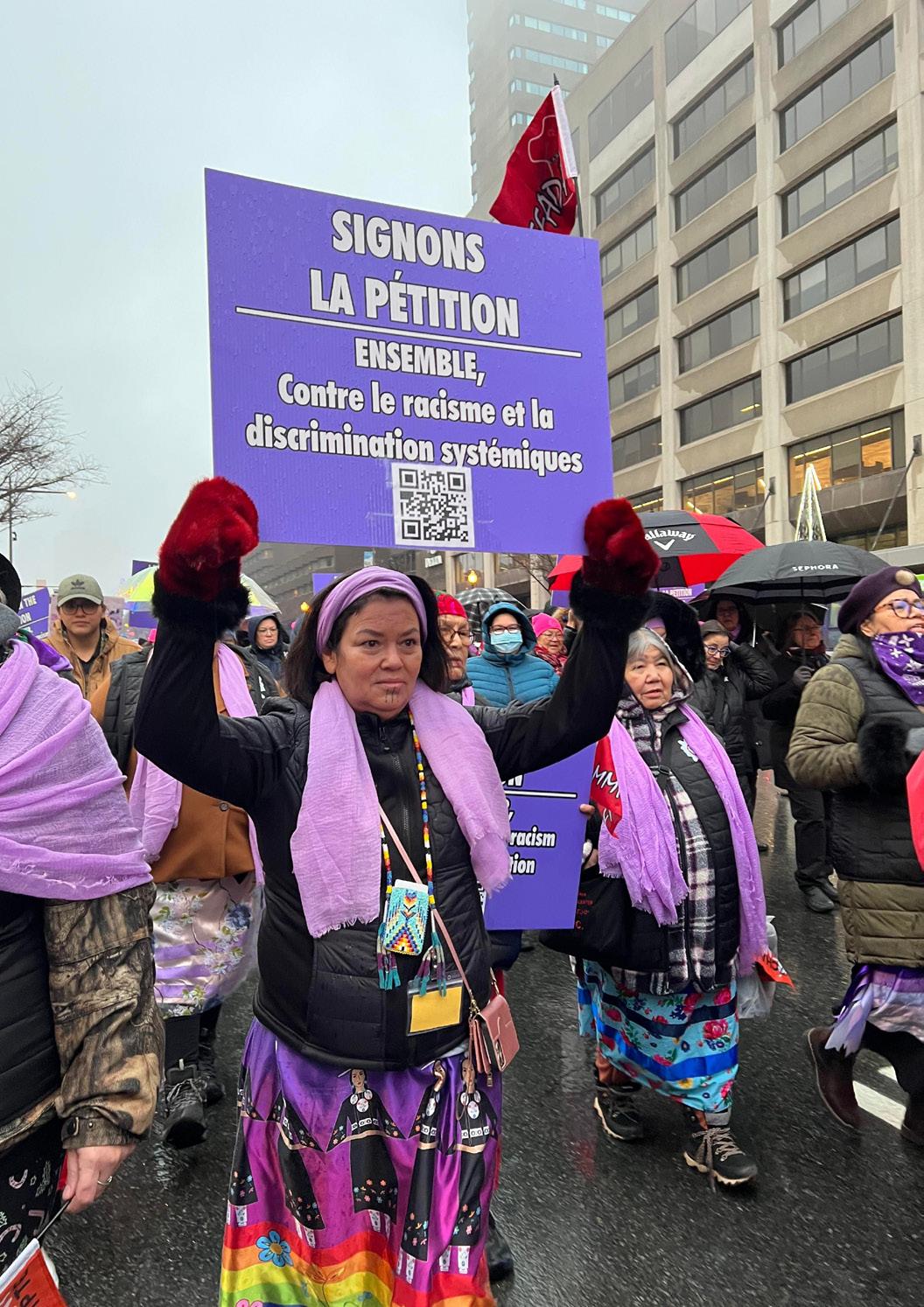
“What stood out for us is there was no data from Quebec,” Bouchard told The Nation. “That was why we mobilized many Indigenous organizations to lead the first project on the subject, to make sure it was culturally safe and relevant in collecting these testimonies.”
With the pandemic upending in-person meetings, an estimated 20 potential participants declined to follow through with online interviews. Bouchard speculated that the language barrier and traumas reawakened from other
issues may have further limited involvement.
Several testimonies confirmed doctors didn’t accurately explain the risks of tubal ligation or hysterectomy, which were proposed as the only method of contraception available. During prenatal visits, the women didn’t receive any information or medical advice about these irreversible procedures – some had initially been hospitalized for bladder or tonsil surgery.

“We were told [my late sister] was going down for a tonsillectomy, and when she came back, we found out she had a tubal ligation,” stated one testimony. “She never spoke about it. I was trying to cheer her up: ‘Well, you must have had a lousy doctor. Your tonsils are in here, and your fallopian tubes are down there.’”
Patterns of discriminatory treatment, degrading remarks and hostile attitudes painted a distressing portrait of the province’s healthcare system. Some reported not being provided the same pain relief as other patients. In a particularly shocking finding, three women reported imposed abortions.
One of them went to a community clinic with stomach pain. She suspected she was pregnant, but the medical team didn’t think so. In the examining room, an instrument was inserted without warning by a nurse, triggering sharp pain and blood loss. The nurse later told her, “You would have done the same anyway.”
“These words have haunted her since,” shared Bouchard. “It was negligence or malpractice that led to a miscarriage. It’s hard for me to wrap my head around how vio-
24 the Nation December 16, 2022 www.nationnews.ca Updates
Politics
lent this is. It’s the antithesis of everything we should be doing in healthcare.”

This “continuum of colonial violence” gained widespread attention following the death of Joyce Echaquan, the Atikamekw mother of seven who died in 2020 amidst a flurry of abusive, sexist and racist remarks from medical staff at a hospital in Joliette. While women experiencing similar treatment have remained silent, Echaquan was named by at least one participant as her motivation for joining the study.

Although such situations have led many Indigenous women to fear hospitals, the Coalition Avenir Québec government under François Legault continues to deny the presence of systemic racism. Indigenous health professionals have denounced the sensitivity training introduced after Echaquan’s death as “superficial” and “cringe-worthy”.

On December 3, Quebec Native Women organized a gathering near The National Assembly to protest systemic racism and demand the adoption of Joyce’s Principle, a call to guarantee Indigenous people the right to equitable access without discrimination for all health and social services.
“For Joyce’s memory, we will never abandon the mission she left as a legacy to all of us,” Echaquan’s mother Diane Dubé said at the gathering. “Her cry will never be lost. Our cultures must regain respect and dignity… systemic racism must be eliminated to allow our peoples to receive the services to which all humanity is entitled.”
The report’s authors are expecting robust responses to these issues. Among their
recommendations are better education tools to promote women’s rights, training for healthcare professionals and support for class action lawsuits brought by victims of imposed sterilization and obstetrical violence.
“The main message is believing women, welcoming them and learning from their stories,” asserted Bouchard. “Saying no more. Acknowledging the strength and courage of the women who came forward and also those who haven’t yet come forward.”
Quebec Indigenous affairs minister Ian Lafrenière applauded the report and announced December 2 that a bill will pass within the month to ensure cultural sensitivity in the province’s healthcare law.
Quebec’s College of Physicians strongly reiterated the importance of obtaining clear and informed consent from patients before any procedure. The college’s president, Dr. Mauril Gaudreault, planned to meet with Basile and Innu surgeon Dr. Stanley Vollant to develop new processes that would encourage Indigenous women to submit complaints and hold practitioners accountable.
Advocates believe that the courage of this study’s participants will empower other women to come forward.
“All of the women we interviewed were speaking up because they don’t want this to happen to any other Indigenous women,” explained Bouchard. “Their bravery and openness in sharing with us such a vulnerable part of their lives needs to be highlighted. They are the reason for every word of the report and every step that led us to this moment.”
www.nationnews.ca December 16, 2022 the Nation 25
ᐐᒋᐦᐄᐙᐅᐎᓐ Are you going through a tough time? If you need to talk, we’re here for you. creehealth.org/helpline WÎCHIHÎWÂUWIN HELPLINE 1-833-632-4357 (HELP) 24/7 • free • safe • confidential Our
service
confidential and
your needs, with
Wîchihîwâuwin Helpline Team is ready to support you 24/7. This
is
adapted to
Cree speakers and traditional healers available.


Peace, love, health and prosperity for the New Year 2023.
Chief Allan Jolly, Council and Staff of MoCreebec Eeyoud




Maximum Dignity
Cree organizations host special needs symposium to improve services for the disabled
by Ben Powless, Local Journalism Initiative Reporter
The Cree School Board organized a Special Needs Symposium in Gatineau from November 29 to December 1, in conjunction with Child and Family Services of the Cree Nation Government and the Disability Programs Specialized Services of the Cree Health Board.
It was a chance for parents and caregivers of children with special needs to connect, attend workshops that offered educational and practical tools, and to provide feedback to the different bodies of the CNG. The gathering comes after 2022 was declared the Cree Year of Special Needs. About 300 chil-
dren, family members, social workers, educators and others attended.
A 2017 study showed there were 900 children across the Cree communities with spectrums of special needs or disabilities.
CSB Chairperson Sarah Pash told The Nation that all too often, parents and caregivers of these kids feel isolated, that their needs aren’t being met, and that they’re not being heard. She said this was especially true during the pandemic, when parents struggled to find services and keep up with their children’s lesson plans.
She hoped the conference would ensure not only “that parents feel good, that they’re learning and feeling empowered, but as the Cree School Board, we’re hoping to take away information to plan to address the gaps and systems to support everyone with special needs and diverse learning needs.”
Before the conference, the CSB held community dialogues in six of the Cree communities, where they invited parents to learn about services and supports offered and to share feedback on their needs. Pash said that this information was used to create the content for the conference.
Three communities were unable to host dialogues because they were in mourning, including Whapmagoostui, Waswanipi and Ouje-Bougoumou, and Pash said the CSB will return to those communities in January to report on
their action plan and get feedback on the plan.
The school board also brought in Child and Family Services under the CNG, which manages daycares, and the Disability Programs Specialized Services of the CBH, which already deals with many of the special needs individuals. Pash said the school board developed a protocol with the CHB to support individuals with special needs and to share information between the two institutions.
One of the main challenges for the Cree education system is to move beyond a Western understanding of disability, according to Pash. She said that approach focuses on a “deficit perspective” where kids are defined by what they don’t know or can’t do.

Instead, she wants to evolve an approach based on Cree values and culture, which see every child as being teachers, as having their own gifts, and to demonstrate that they are loved and valued.
Parental feedback identified goals such as community awareness weeks,



28 the Nation December 16, 2022 www.nationnews.ca
Community
more ramps and sidewalks, adapted equipment and vehicles, land-based healing and education, and centres for those with special needs that would support them living and working “as independently as possible, with as much dignity as possible,” according to Pash.

But perhaps the biggest change would be in how the community responds to individuals with special needs, she explained. “There’s a need for awareness and for the entire community to be a support system,” she added.

Pash said that she used to be a special-ed teacher and is also a parent of a child with a special needs file. “So, this comes from a personal space,” she said.
Stella Masty, CNG negotiator and file holder for the conference, agreed. “There’s a disconnection. People need to feel a belonging to community. Not
just wrap-around services, but also outside of the home and community,” she said.
“Lots of families feel isolated, people don’t know how to communicate with them,” she added. In addition to raising awareness and teaching people how to talk to those with special needs, she said there was a need for legislation, policies, funding and family support for full-time caregivers.
Parents also feel isolated politically, she admitted, since the issue was being passed off between the school board or the health board to deal with. However, she said the Grand Chief, Mandy GullMasty, indicated she wouldn’t shove it around.
Masty said the CNG was focused on “removing silos” to ensure that special needs children and their families could access diagnoses and services in a timely manner, noting that there can be long delays in getting appointments
which then force them to travel outside the community, leaving other children at home.
Masty also pointed to a need for universal screening. The study that pointed out 900 children with special needs was only based on a limited survey. She said the CBH indicated it worked with 80 to 90 clients who were living off reserve.
“It takes a community to raise a child, to raise and uplift a family that needs support. We’re trying to do it in a Cree way,” she added.
Masty said the conference is just a first step, and now the CNG will be focused on pushing for programs, services, legislation and funding, including from Quebec and Canada. For their part, the CSB is planning another symposium for next fall, this time for educators and other staff.
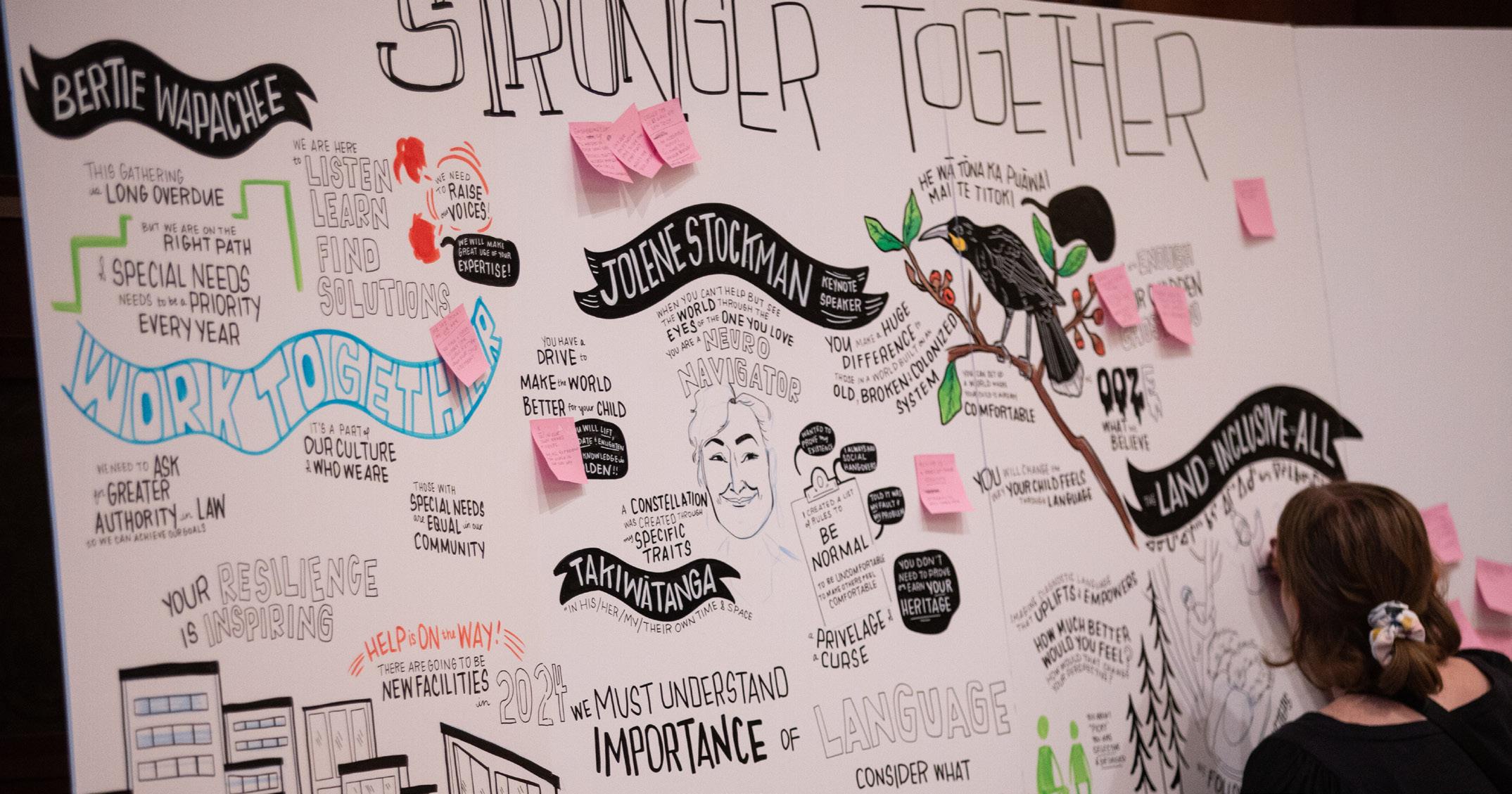
www.nationnews.ca December 16, 2022 the Nation 29
fabric companions made in Montréal
15% OFF with the code"NATION". Valid on raplapla.com until Dec 31, 2022




If you are an Indigenous are seeking safety /services/womens-shelters-robins-net For women and children domestic 1 855 753-2094 CRISIS If you are an Indigenous woman of Eeyou Istchee and you are seeking safety and support, we are here to help you! creehealth.org/services/womens-shelters-robins-net Pîpîchâu Uchishtûn | Robin’s Nest | Women’s Shelter For women and children of Eeyou Istchee suffering from domestic violence 1 855 753-2094 CRISIS LINE Toll Free | Open 24/7 HELP ᐐᒋᐦᐄᐙᐅᐎᓐ WÎCHIHÎWÂUWIN HELPLINE If you need emotional support or to learn about all the services available to you, please contact us: 1 833 632-HELP (4357) creehealth.org




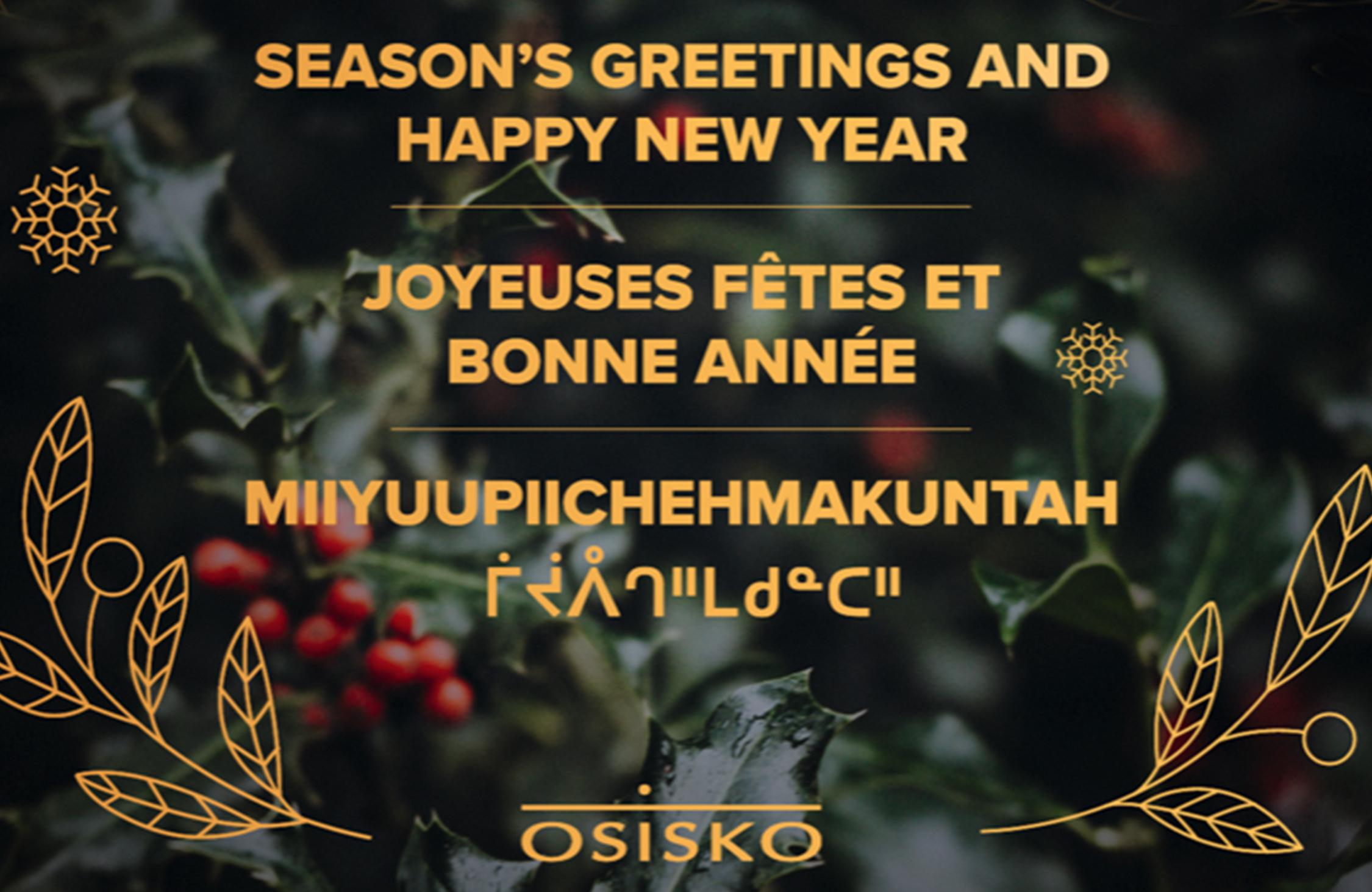
Indigenous woman of Eeyou Istchee and you safety and support, we are here to help you! /services/womens-shelters-robins-net Pîpîchâu Uchishtûn children of Eeyou Istchee domestic violence 753-2094 CRISIS LINE Open 24/7 creehealth.org




The holidays are fast approaching. Get vaccinated against COVID-19 now so you’ll be protected in time. Make an appointment at Québec.ca/COVIDvaccine
Prepping for Christmas
by Sonny Orr
Iused to think that putting up Christmas decorations right after Halloween was rather early. But now, more than a month later, I realize the wisdom of that logic. It’s akin to shopping for presents before the December madness that has tortured us for the last century. Or you could think of it as the need to gather provisions before the cold weather arrives.
I always liked Christmas and what it meant. I’m talking about the mystery behind the reason we go nuts in the shopping malls. The need to give and receive is relatively recent; most of our people simply did not have the money to spend on gifts until the past couple of generations.

As the population grew along with the number of retail outlets across the continent during the last century, the desire to give overcame the traditional concept of Christmas. In other words, the birth of a certain being who would, centuries later, become a driving force in a belief system.
Around Christmas, the outlines of those belief systems get a little blurry. Now generalized to “The Holidays”, this part of the year means we have some time off from the daily grind we endure in order make the money we need to spend during those holidays. Ahh, life in general, never a simple concept.

As I look out across the frozen landscape called my backyard, I see that others, only a few degrees lower in latitude, are walking in running shoes through gloriously sunny and snowless terrain. This, even as they complain that their footwear
is getting too acclimatized to southern Canada. Will someone once again come up with moccasins to cover just about every temperature range and humidity index? That’s on my Christmas wish list.
Only 1,000 kilometres away, late fall is still present and waiting for that funny thing called winter. I meet seasoned travellers from the far north who complain about the cold in the south. “It’s cold to the bones,” claimed one recent traveller returning home to Inuit country.


I wasn’t surprised. I’ve spent many a winter in the so-called south, only to find the snowless city almost unbearably cold. Every inch of exposed skin was a candidate for frostbite. Amazingly, I survived Montreal’s humid winters, and vowed never to complain about our dry cold that stays outside and doesn’t penetrate below a few layers of normal winter clothing. At least our dry northern snow is clean and free of slush until April.
I used to think that Christmas was a great time for everyone. A time to reflect on our blessings and to perform or benefit from a random act of kindness that reinforced that Christmassy feeling in an old grouch like me.
On occasion, I would get a little sad around this time. But that’s now pretty much behind me as I welcome the cries
of joy from the little grandchildren who repopulate our empty nest, filling it with happiness. Yes, all that work, sacrifice and other little things like blood, sweat and tears are washed away by sharing love, friendship and happiness with children. I’ve now hung up my Grinch outfit for good.
On that note, some rules for Christmas:
First, believe in Santa Claus, mainly because he can take the blame for that ugly sweater or duplicate coffee pot –or because he forgot to make a gift for the cousin or nephew who you see only once a year. Who? Oh yeah, the kid in the middle!
Don’t forget about chocolate. You never go wrong with chocolate.
The usual fruitcake? Try the artisan kind. Those are never wasted in the garbage only to become worm food when the ice melts.
Finally, socks are the best gift. They are something you can lose but always need.
So, as the days wind down to Christmas stocking time again, let’s not forget to thank Santa – with plenty of electronic money transfers, please! The milk and cookies only go so far! Sorry, that’s the Grinch in me that I forgot to put away. Happy Holidays everyone!
www.nationnews.ca December 16, 2022 the Nation 33
Rez Notes
T T T
I always liked Christmas and what it meant. I’m talking about the mystery behind the reason we go nuts in the shopping malls.
In memoriam
by Maïtée Labrecque-Saganash
Iwas reading Christopher Curtis’ piece in his online publication The Rover about the passing of Alexandra de Kiewit, a Montreal advocate for people who use drugs, sex workers, and people living with HIV. I did not know Alexandra personally, but as an advocate for harm reduction and safe-use policies, I greatly admired her work.
De Kiewit was on numerous boards, part of many initiatives and would travel the world to advocate for people’s dignity. She was always honest about her own intravenous drug use. She saved so many lives, despite her addictions, because addictions don’t define people.
According to de Kiewit, “Once we let go of the judgment and see overdose deaths as a failure of government policy, people will stop dying.”




Activists like de Kiewit started ringing the alarm about the opioid crisis many years ago. However, public policies have yet to follow. What I thought was an urban problem is starting to reach Northern communities; last summer, there have been overdose-related deaths in Nunavik because of drugs laced with fentanyl that were bought in Montreal. According to a friend in Puvirnituq, a community member was buried wearing her wedding dress, as she was supposed to get married not long after coming back from down South.
In most Cree communities, the only ones who have Naloxone in their inventory are the healthcare workers in clinics and first responders. Naloxone is a
fast-acting medication that temporarily reverses the effects of opioids and can stabilize a person who overdoses while they await urgent care.
If you are wonder if people feel confident calling emergency services when their buddy is overdosing, they don’t. Profound distrust in healthcare and police services, and lack of literacy on users’ rights come into play when community members face such situations. People would rather leave their friend in front of the ER, ring the nurse and leave than calling emergency right away.
When a person overdoses, every minute counts, and the sooner Naloxone is administered the better. As communities, we should consider distributing Naloxone to drug users so that they can save a life if they must. Because yes, people who live with addictions deserve to live too.
Over the holidays, some people tend to isolate during that time to use. I think we should consider such initiatives in our communities, even if the opioid crisis is hitting harder in big cities. Better safe than sorry; we should take this opportunity to start educating people and breaking down the stigmas.
Days after Alexandra de Kiewit’s passing, I read a Facebook post written by her friend. The post reads: “But you didn’t die of an overdose, you didn’t die of AIDS either. You’re dying a natural death as a punk who got to choose her life, burning it all at both ends of the candle, your beautiful, bright candle.”

We should always remember that the key to recovery is preventing early deaths. In the New Year, I hope we choose compassion and stop pushing people to the margins of our communities.
Wehavebeenpresent since1939.Allmembers ofthelargeDeshaies' familyarebyyourside todayandwillalsobe forthebetterdaysto
Wehavebeenpresent since1939.Allmembers ofthelargeDeshaies' familyarebyyourside todayandwillalsobe forthebetterdaysto come.

34 the Nation December 16, 2022 www.nationnews.ca
Bannock T&B
Tea &
When a person overdoses, every minute counts, and the sooner Naloxone is administered the better. As communities, we should consider distributing Naloxone to drug users so that they can save a life if they must.





FOR MORE INFORMATION, CONTACT: Judy Nakogee , Nishiiyuu PPRO Phone: 418-770-4037 SAVE THE DATE! MIYUPIMAATISIIUN COMMITTEES GATHERING FORMALIZING SHARED RESPONSIBILITY AND ADDRESSING SOCIAL ISSUES Fe b r u a r y 2 1- 2 3 , 2 0 2 3 D e l t a M on tr éa l FOR MORE INFORMATION, CONTACT: Judy Nakogee , Nishiiyuu PPRO Phone: 418-770-4037 E-mail: Judy.Nakogee@ssss.gouv.qc.ca SAVE THE DATE! MIYUPIMAATISIIUN COMMITTEES GATHERING FORMALIZING SHARED RESPONSIBILITY AND ADDRESSING SOCIAL ISSUES Fe b r u a r y 2 1- 2 3 , 2 0 2 3 D e l t a M on tr éa l
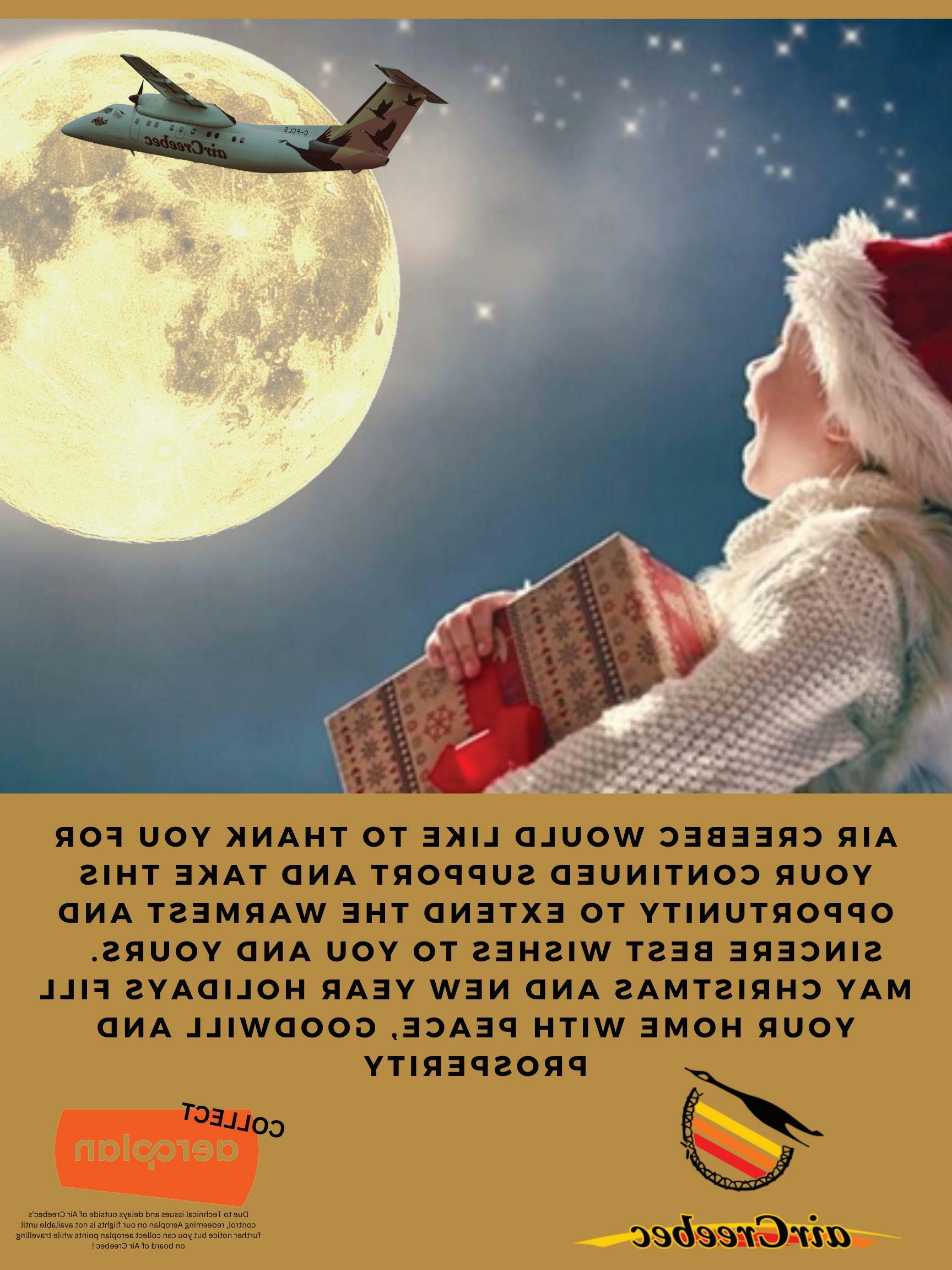






































 by Ben Powless, Local Journalism Initiative Reporter
by Ben Powless, Local Journalism Initiative Reporter


























 by Patrick Quinn, Local Journalism Initiative Reporter Photo by Maude Debois
by Patrick Quinn, Local Journalism Initiative Reporter Photo by Maude Debois























































